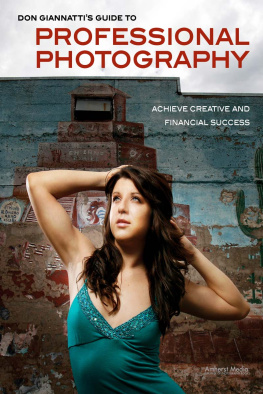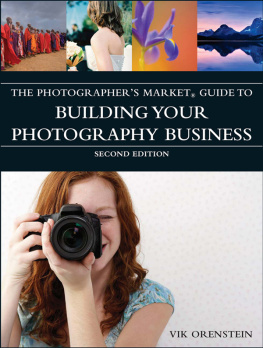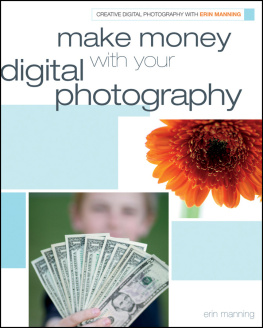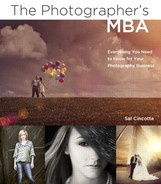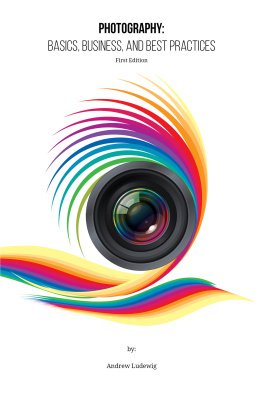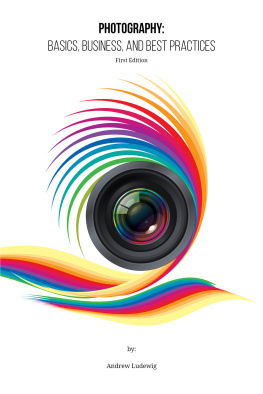Check out Amherst Medias blogs at: http://portrait-photographer.blogspot.com/
http://weddingphotographer-amherstmedia.blogspot.com/
Copyright 2013 by Don Giannatti.
All photographs by the author unless otherwise noted.
All rights reserved.
Published by:
Amherst Media, Inc.
P.O. Box 586
Buffalo, N.Y. 14226
Fax: 716-874-4508
www.AmherstMedia.com
Publisher: Craig Alesse
Senior Editor/Production Manager: Michelle Perkins
Assistant Editor: Barbara A. Lynch-Johnt
Editorial assistance provided by Sally Jarzab, John S. Loder, and Carey A. Miller.
ISBN-13: 978-1-60895-516-9
Library of Congress Control Number: 2012936505
Printed in the United States of America.
10 9 8 7 6 5 4 3 2 1
No part of this publication may be reproduced, stored, or transmitted in any form or by any means, electronic, mechanical, photocopied, recorded or otherwise, without prior written consent from the publisher.
Notice of Disclaimer: The information contained in this book is based on the authors experience and opinions. The author and publisher will not be held liable for the use or misuse of the information in this book.
C ONTENTS

These things are bumpers for the ferries that run from Galveston to a small island nearby. I used the dramatic cloud to make a shot that created much more interest and mystery. The reflection helped make the image more dynamic, and the colors really popped.

For me, traveling is one of the perks of being a photographer. Being able to see places and be places that are unusual is a blast. This image was taken fifteen minutes before sunrise on a little island near Galveston, TX. The landings and piers had been destroyed by a hurricane, and I thought they looked so mysterious reaching out into the Gulf like that. The colors in the sky were so subtle and magnificent, and I wanted to catch their reflection on the nearly still water in the bay.
D EDICATION
Thanks to my wonderful wife, Marian, and my daughters Shanna, Michaila, and Alissa for their ongoing support on this book project. Writing takes me away from family, but their love and support make it work out fine. A big thanks goes out to all the photographers and workshop students who have made my photographic experience truly exceptional. Finally a big shout out to all the folks who have been part of my photographic journey, particularly the great shooters of Project 52. You guys kept me focused, and that is quite a feat! For all the photographers who have taken my workshop, worked in Project 52, or been online budsthis ones for you. I hope you have every dream fulfilled.
S PECIAL T HANKS
Special thanks go out to the models and talent appearing in this book.
I NTRODUCTION
Getting Into the Business
Becoming a professional photographer is a lot easier these days than it was when I started out. The available equipment is better, we get instant feedback, the learning curve isnt very steep, and there are an infinite number of options for finessing our images to achieve our creative vision. It also requires less of a financial investment to start a business.
During my first years in business, I saw expenditures of hundreds of thousands of dollars for studio build-outs, gear, strobes and modifiers, a full kitchen, makeup area, location truck, cameras in various formats, numerous lenses, and a place to tie my horse up and keep the flint lock guns dry.
Im not complainingthat was simply the way it was. We coped, made the money, and stuck it back into the studio in hopes that it would pay offand it did, at least for me. As a self-employed photographer and designer, I never had a bank loan or a line of credit. I did it all with cash. If I couldnt afford something, I worked, saved money, and bought what I needed.

This shot was made using a 5x7 Toyo view camera, a 210mm Nikkor lens, and Ektachrome film. A large studio bank light was positioned above the subject. It produced soft light and a brilliant specular on the shiny vegetables that livened up the image. The shot was printed 20 feet wide for a point-of-purchase display at a local natural foods grocery. This was a straight shot; there was no work done in Photoshop.

Creating a catalog for a custom silversmith was tedious but lucrative. I used a 5x7 Toyo, 90mm Nikkor, and Ektachrome film to make a cover shot that would convey the art of silver-smithing. I gathered the props from the artists studio and took them to mine for the photography.The tools were composed to keep the eye in the middle of the page, and the empty area at the top left was for the name and logo of the company. To create the final image, I cropped a bit from the top. This was a straight shot; there was no editing done in Photoshop.
I was not and have never been a famous photographer gallivanting all over the world to photograph celebrities for elite clients. That wasnt what I went into this business to do. I wanted to make photographs for me and to subsidize that endeavor by making photographs for other people. I could have simply done photography on the weekends and vacations, but that did not provide enough freedom. Also, it wouldnt have been as much fun. I believe the worst days making photographs are still better than most good days doing something else.
I live in Phoenix, Arizona. Phoenix is not the fashion, automotive, or food capitol of the world, but it is a large city with various photographic needs. I have shot numerous catalogs for over four-dozen clients, as well as food, fashion, portrait, editorial, real estate, architecture, and still life images. It is simply what I do. I make photographs.

One of the local TV stations was a consistent client. We did a couple of shots a week for them for TV Guide and local magazine placements, but this shoot was for a special anniversary. The artistic director and his assistant gathered the props, and we shot it with a warming filter to make it look a bit nostalgic.

Here, you can see the image as it was used. They killed the headline when they saw the imagethey wanted it to be prominently featured. The shot was made with a 4x5 Toyo, 90mm Nikkor lens, Ektachrome film, and an amber filter to warm the image. This is a straight shot. There was no editing done in Photoshop.
Specialize or Generalize?
Every photographer who enters this business needs to decide whether they want to specializeto focus, say, on food or fashion photography, or perhaps travel and corporate clientsor to be a jack of all trades and provide images in all genres. When I got started, I could have decided to specialize in something, but that would have severely limited my income. I did have areas that I marketed more, and jobs I went after in the genres I preferredfashion, portraiture, still life, and product photographybut I also maintained books in architecture, real estate, food, and environments. To be blind to those possibilities was not a smart idea.
Next page
